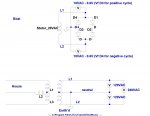KRH1326
Chief Petty Officer
- Joined
- Sep 22, 2007
- Messages
- 491
hi everyone... been a while since I was in these forums.
im not a Merc guy, and this issue is driving me crazy. It’s my son’s, new to him, 1990 90 HP. It looks like serial number 0C272485.
it has a low amp stator and a rectifier... no regulator. Simple three terminals on rectifier. The ++ term is for red wire to batt on starter solenoid. The other two each get a yellow stator wire, and one brown for tach.
I tested the stator as per book. Continuity from yellow to yellow wires.... aok. No continuity from either yellow to good ground... aok.
i tested the rectifier as per book and found it faulty, by ohmmeter. I bought a new quicksilver rectifier, and installed it. No sign of any charging. I pulled it, and tested it and it comes up faulty per the book, by ohmmeter testing. I reinstalled it, just so my son can still run boat... and he tells me that he seems to be maintaining 12.1 -12.2 volts, via the little voltmeter/ phone charger, I had installed for him.
ok... I get a chance today to investigate further. I pull and retest the rectifier.. shows faulty as per book and ohmmeter. I take it with me, back to dealer, and he tests it, as faulty. He actually gives me another new one. For the heck of it, in the parking lot I test it. It too comes up faulty. I know it’s a different one because I opened the package, and my “old one” was still on the counter. I show him, and he tests it. My vision is poor and couldn’t see his meter numbers, but he says it checks out. Ok so I think there could be something wrong with my meter.
I go back to mooring, and install the second rectifier. I double checked the stator wires and ground readings, just for fun. Still shows aok.
fire up motor and it still seems to be trying to maintain that 12.1 / 12.2 voltage. I could see meter drop to 11 with the starter engaged. Once running it returns to 12, then with high idle it comes back up to 12.1
I play with the tilt/ trim and meter drops into 11’s. Then comes back up to 12.1 volts with high idle. I attempt the test, from the book, of placing ammeter inline between rectifier ++ term and the disconnected red wire to starter solenoid/ batt..... I cant read any amperage !
i pull of all wires on rectifier and test it for the hundredth time. Still checks as faulty.
so here I am , asking for help, lol
is my test meter failing ?
does this Merc low amp , non-regulating stator really only maintain about12.1 / 12.2 volts ? Am I possibly missing something? Would love some input before I buy another rectifier, from a different place , lmao
im not a Merc guy, and this issue is driving me crazy. It’s my son’s, new to him, 1990 90 HP. It looks like serial number 0C272485.
it has a low amp stator and a rectifier... no regulator. Simple three terminals on rectifier. The ++ term is for red wire to batt on starter solenoid. The other two each get a yellow stator wire, and one brown for tach.
I tested the stator as per book. Continuity from yellow to yellow wires.... aok. No continuity from either yellow to good ground... aok.
i tested the rectifier as per book and found it faulty, by ohmmeter. I bought a new quicksilver rectifier, and installed it. No sign of any charging. I pulled it, and tested it and it comes up faulty per the book, by ohmmeter testing. I reinstalled it, just so my son can still run boat... and he tells me that he seems to be maintaining 12.1 -12.2 volts, via the little voltmeter/ phone charger, I had installed for him.
ok... I get a chance today to investigate further. I pull and retest the rectifier.. shows faulty as per book and ohmmeter. I take it with me, back to dealer, and he tests it, as faulty. He actually gives me another new one. For the heck of it, in the parking lot I test it. It too comes up faulty. I know it’s a different one because I opened the package, and my “old one” was still on the counter. I show him, and he tests it. My vision is poor and couldn’t see his meter numbers, but he says it checks out. Ok so I think there could be something wrong with my meter.
I go back to mooring, and install the second rectifier. I double checked the stator wires and ground readings, just for fun. Still shows aok.
fire up motor and it still seems to be trying to maintain that 12.1 / 12.2 voltage. I could see meter drop to 11 with the starter engaged. Once running it returns to 12, then with high idle it comes back up to 12.1
I play with the tilt/ trim and meter drops into 11’s. Then comes back up to 12.1 volts with high idle. I attempt the test, from the book, of placing ammeter inline between rectifier ++ term and the disconnected red wire to starter solenoid/ batt..... I cant read any amperage !
i pull of all wires on rectifier and test it for the hundredth time. Still checks as faulty.
so here I am , asking for help, lol
is my test meter failing ?
does this Merc low amp , non-regulating stator really only maintain about12.1 / 12.2 volts ? Am I possibly missing something? Would love some input before I buy another rectifier, from a different place , lmao




















